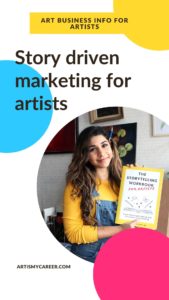< Marketing
Story-driven marketing for artists and creatives

Think back to the last time you had a catch-up with someone you really care about. You probably shared stories and bounced off each other with topics that you both found engaging, right? This is how we humans communicate, and we’ve been doing it since the dawn of time. Stories stay with us for our whole lives, they are passed on through generations and they are attached to every memory we have.
Why then, do so many people fall into the trap of using facts, figures, specifications, and infographics when trying to market their art business? When did you last connect with someone over a shared statistic, instead of a shared experience? This is where story-driven marketing comes in, and it’s going to transform the way you think about selling your art.
Everything you need to know about story-driven marketing for artists:
1. What is story-driven marketing?
2. Why is storytelling an important part of art marketing?
3. How can you use storytelling to get noticed?
4. How can you use story-driven marketing in your art business?
5. What is the storytelling workbook?
[widget id=”woocommerce_products-4″]
What Is Story-Driven Marketing?
The essence of all good marketing is the ability to tell a compelling story, and this is probably even more true for artists than anyone else. As an artist, you have a unique ability to express yourself and create an emotional connection with your followers, and your marketing should do the exact same thing. Storytelling is the key to making this happen. When people hear an amazing story they want to know more, they share it with other people and they want to get involved.
Big brands know this more than anyone. Telling the right story can take your product from a commodity that is judged on price and features to being something customers care about and are emotionally invested in as part of their own journey. Take Red Bull, the energy drink company. They use storytelling all the time to bring their product to life, to the extent that when you think Red Bull, you instantly imagine extreme sports and adventures as much as a can of drink. Once you start looking for it, you will see storytelling all over corporate ad campaigns, because it works.

Storytelling Is An Important Part Of Art Marketing
Story is just as important to artists as it is to mainstream brands. Some of the most famous artists in history are as famous for their life story as they are for their work. Banksy, now world-famous, has roots in the underground Bristol street artist scene, something which is reflected in his work again and again. His story is authentic and in tune with the rebellious tone of his artworks. It is the story behind an artist’s work that adds intrigue, context, and a connection to something we can feel. Without this back story, his work simply wouldn’t have the same raw appeal that it does today.
Van Gogh’s Starry Night is famous for having been painted at a sanatorium after the artist suffered an acute mental breakdown. Knowing this story behind the work gives it context, meaning and allows us to see it in a new light. Van Gogh’s turbulent adventures across Europe form the basis for many of the stories he tells through his work, and are what he is remembered for as much as his painting.
There is a good business case for using storytelling to market your art too. In a study featured in Adweek, storytelling was proven to increase the value customers placed on advertised products.
For example:


To put it simply, people are more willing to spend money on something when they know the story behind it.
If you are going to connect with your audience and market your art effectively, you need to start telling stories instead of listing specifications, facts and figures. Using storytelling in your art business will make your marketing more effective, more enjoyable and altogether more authentic.
Using Storytelling To Get Noticed
We’ve all seen a huge rise in the number of artists on social media in the last few years. There are so many amazing artists out there, it can feel impossible to get noticed sometimes. This is where good storytelling comes into its own.
If your commission business involves selling personalized wooden boxes, you will have a lot of competition on sites like Etsy. Lots of people sell similar boxes here, and you are reduced to dropping your prices in order to compete. If you sell wooden boxes, but also tell stories behind making each box, your love of the forest and of sustainable timber, suddenly you stand out amongst the crowd. Effective storytelling is what differentiates you from everyone else, nobody has your same story, inspirations or experiences which makes them your most effective marketing tool.
However, people can’t connect with your art or you unless you present them with reasons to connect. What are you and your customers shared values? What is important to you both? What have you done that your customers would find intriguing or inspiring? What makes your work different? The sooner you start sharing, the sooner they will start listening.

How To Use Story-Driven Marketing In Your Art Business
Storytelling should be in every activity you undertake as an artist. From creating original works to posting on social media, everything you do should come with a compelling story attached, rather than a boring description of the facts. This is your chance to have some fun and use your imagination to spot a good story that you can build your marketing around.
One challenge if you are a commission-based artist is that your art doesn’t necessarily reflect your own original work. This is a great opportunity to tell your customer’s story, subjects story or your own love of commission work. Remember, we are trying to create stories that both we and the customer can relate to, so their side is just as valid as yours, and will likely connect to other customers in a similar way.
The best storytellers show, rather than tell
Just as you do in your social life, the stories you share should be told in a way that appeals to the person you are speaking to. If you are talking to a gallery with a view to being represented by them, you would take a more professional tone than if you are sharing a fun “guess what happened in the studio today” style post on Instagram. Stories are always contextual, but pick the right ones and they can add real depth and authenticity to everything you do.
The best storytellers show, rather than tell. Pictures and videos make this especially easy and are great for social media. If you get into the habit of recording your progress as an artist you will have an amazing archive to look back on and use for content. The same story can be told in 5 different ways depending on the platform you are using to share it. A LinkedIn post will be very different to an Instagram Story, but they will contain the same core themes. The platforms you use to tell stories on will depend on the audience you are trying to reach.
[widget id=”woocommerce_products-4″]
The Storytelling Workbook for Artists
Learn how to get noticed with the power of storytelling.
[/vc_column_text][/vc_column][/vc_row][vc_row css_animation=”fadeIn”][vc_column][vc_empty_space height=”20px”][vc_video link=”https://www.youtube.com/watch?v=fdCewKUYdv8″ el_width=”90″ align=”center”][vc_empty_space height=”50px”][/vc_column][/vc_row][vc_row][vc_column width=”2/3″][vc_column_text]
If you have started your own art business, you may have reached the point where you’ve got a website, social media page, and maybe business cards… you are now ready to take it to the next level.
With the help of this workbook, it’s time to reinject some soul back into your business and get noticed with the power of storytelling.
This is going to answer the important questions that differentiate you from your competition and will help you communicate what make you special as an artist.
It is divided into three main sections and contains clear actionable points.
This workbook is an editable pdf that you can use on your phone, tablet and computer or print and write!
[/vc_column_text][/vc_column][vc_column width=”1/3″]
[/vc_column][vc_column][vc_empty_space height=”20″][eltdf_social_share icon_type=”font-elegant”][vc_empty_space height=”50″][/vc_column][/vc_row][vc_row content_placement=”middle” css_animation=”fadeIn” simple_background_color=”#fafafa”][vc_column width=”1/2″][vc_column_text]Like this page? Pin it!!
[/vc_column_text][/vc_column][vc_column width=”1/2″][vc_column_text]

[/vc_column_text][/vc_column][/vc_row][vc_row][vc_column][eltdf_separator type=”full-width” border_style=”” color=”#ffd92d” top_margin=”20″ bottom_margin=”20″ thickness=”10″][vc_column_text]
Read more…
[/vc_column_text][vc_empty_space height=”20″][vc_masonry_grid post_type=”page” max_items=”3″ grid_id=”vc_gid:1632571103492-b8e25891-08a6-6″ taxonomies=”80″][vc_empty_space height=”100px”][/vc_column][/vc_row]
